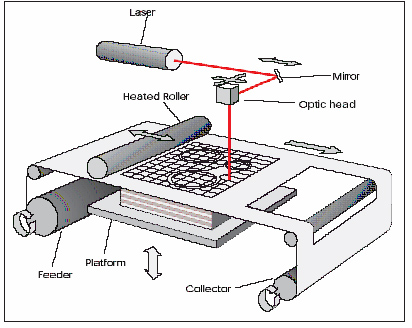Contribute
| Technology - Tissue Engineering Of Cartilage - Part II |
Tejashri Aurangabadkar
11/30/2005
In part I of this article we presented an introduction to the problem of ostroarthritis and an overview of scaffold materials Scaffold manufacturing techniques Rapid Prototyping (RP) techniques are methods that allow producing physical prototypes with reduced manufacturing time, cost and improved quality. Within a rapid prototyping process, the object is first designed on a computer screen and then created based on the computer data. This eliminates predictable errors which usually appear when a model-maker interprets a set of drawings. An essential prerequisite is the computer representation: it is usually a 3D geometrical modeling system like a CAD system, a 3D scanner, computer tomography, etc. Its precision is a key parameter controlling the tolerances of the future model. Others basic principles of RP are the need for specific materials such as fluids, powders, wire or laminates as well as the need for sophisticated equipment employing different physical principles such as laser, sintering, etc. An important difference between RP and traditional techniques is the fact that most of these new techniques build parts by adding material (e.g. layer by layer) instead of removing it. Cells Cells in every organ play a central role in building and maintaining specific tissue function, yet when they are removed from their innate environment, the stability of cellular behaviors is uniformly lost. Therefore, a principal aim of tissue engineering has been to develop a fundamental understanding of the factors in the microenvironment directly surrounding cells which can induce and maintain the stability of differentiated functions. Engineering cellular behavior for tissue reconstruction has focused on the understanding of a number of critical cell functions including: adhesion to matrix and other cells, migration, proliferation, differentiation, and suicide (apoptosis). The biological activity of extracellular matrix appears to depend on every aspect of the cell adhesion process. Adhesion to matrix may be important to localize cells in a pre-defined arrangement and may be required in the case of complex, solid organs. In other cases, migration may be a critical feature for a Tissue Engineered Medical Products. Bioreactors Engineering functional cartilage tissue may be enhanced by the use of bioreactors that provide a controlled in vitro environment over specific biochemicals and physical signals known to regulate chondrogenesis.In particular, bioreactors could improve the formation of cartilage tissues by providing: I. Mixing patterns that result in efficient and spatially uniform seeding of the three dimensional scaffolds II. Enhanced mass transport of chemical species to the cells cultured into the scaffold which increase the cell growth and III. Physical (mechanical and hydrodynamic) simulation of the cell-scaffold constructs during their development. Uniform and efficient seeding of cells on porous scaffolds is an important prerequisite for the development of homogeneous tissue from the lowest possible cell number. Challenges and possible improvement 1. Cell source Cell source approach is limited by the availability of cell, particularly in elderly individuals, and by their capacity to proliferate and to differentiate after expansion in monolayers.It can be overcome by using different cell sources. 2. Scaffolds · Cartilaginous grafts often do not integrate with the host cartilage to form a continuous, mechanically stable attachment this could lead to abnormal stress distribution during physiological activity and degradation in long term. · Materials: Although preliminary results are promising for naturally derived polymers, concerns about the feasibility of finding large amounts of these materials for clinical applications, as well as assurance of pathogen removal has prompted other researchers to investigate the use of synthetic polymers. Synthetic polymers can be easily mass-produced and their properties can be tailored for specific applications. But still the requirement of idle scaffold has not yet achieved by synthetic polymer. · Fabrication Techniques: There are various conventional and rapid prototyping methods are available for fabrication of the scaffolds but currently no one can able to show a promising result. So there is a need of a perfect manufacturing method that can able to give quality product in short period of time with less manufacturing cost. 3. Bioreactors The recent work with bioreactors holds promise that large numbers of cells can be grown efficiently and quickly, pushing cell transplantation to the forefront of new solutions for the problem of cartilage injury. Further studies must be conducted to find an optimal polymer for use in the scaffold. Also, the type of cells (differentiated or progenitor) that are best for this application has yet to be decided. It is the interaction of these two parameters (material and cells), along with the possible addition of growth factors and/or mechanical stimulation to influence cellular development, which will determine the ultimate success of the implant.
You may also access this article through our web-site http://www.lokvani.com/

